Impact of Resource Allocation on London Metropolitan Police
VerifiedAdded on 2023/01/19
|11
|2878
|63
AI Summary
This report explores the impact of resource allocation on the functioning of the London Metropolitan Police. It examines the different types of public sector organizational structures, the concept of culture applicable to public sector organizations, and the role and impact of the national and local government in resource allocation. The report also discusses the relationship between motivation and organizational behavior in the context of the Metropolitan Police.
Contribute Materials
Your contribution can guide someone’s learning journey. Share your
documents today.
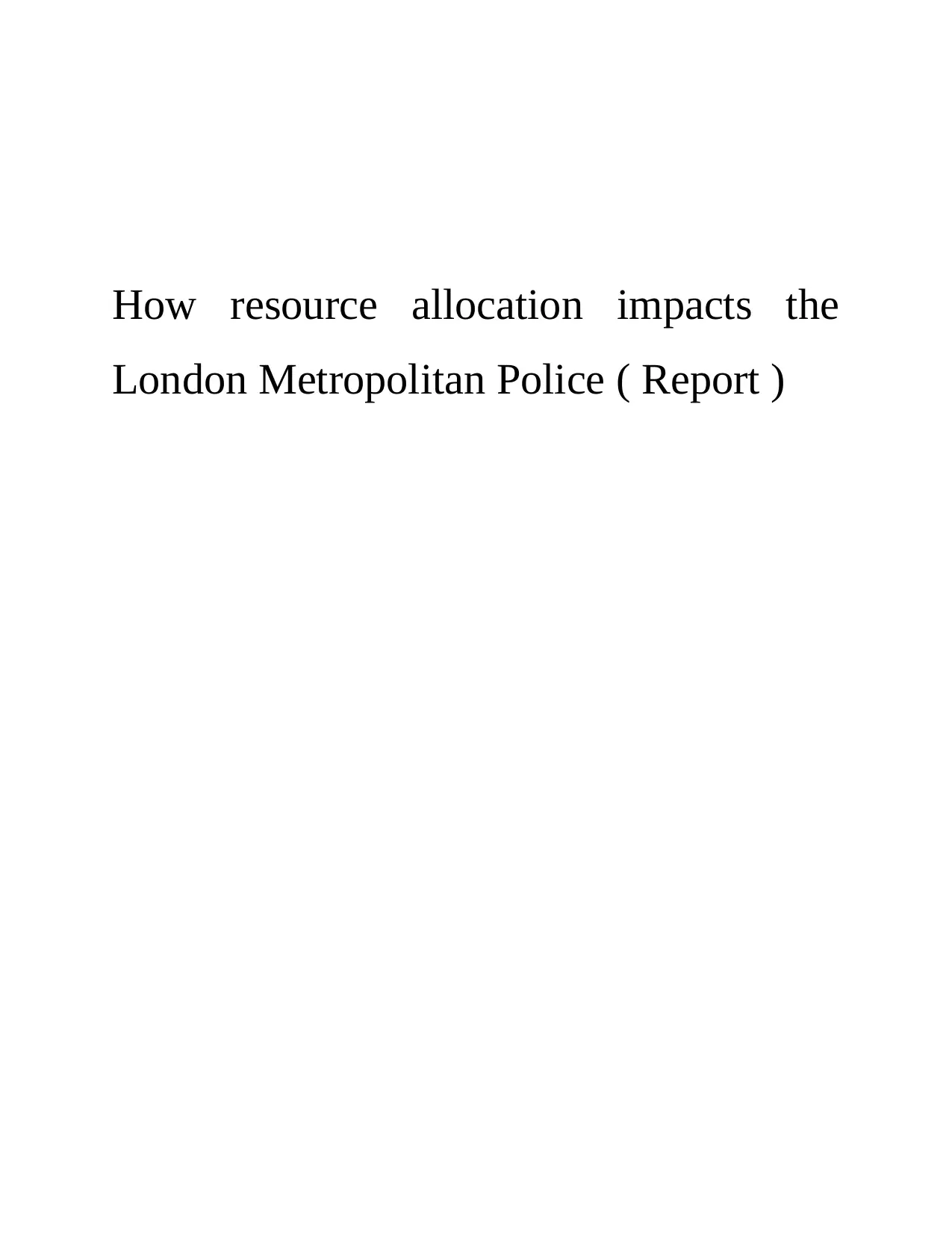
How resource allocation impacts the
London Metropolitan Police ( Report )
London Metropolitan Police ( Report )
Secure Best Marks with AI Grader
Need help grading? Try our AI Grader for instant feedback on your assignments.
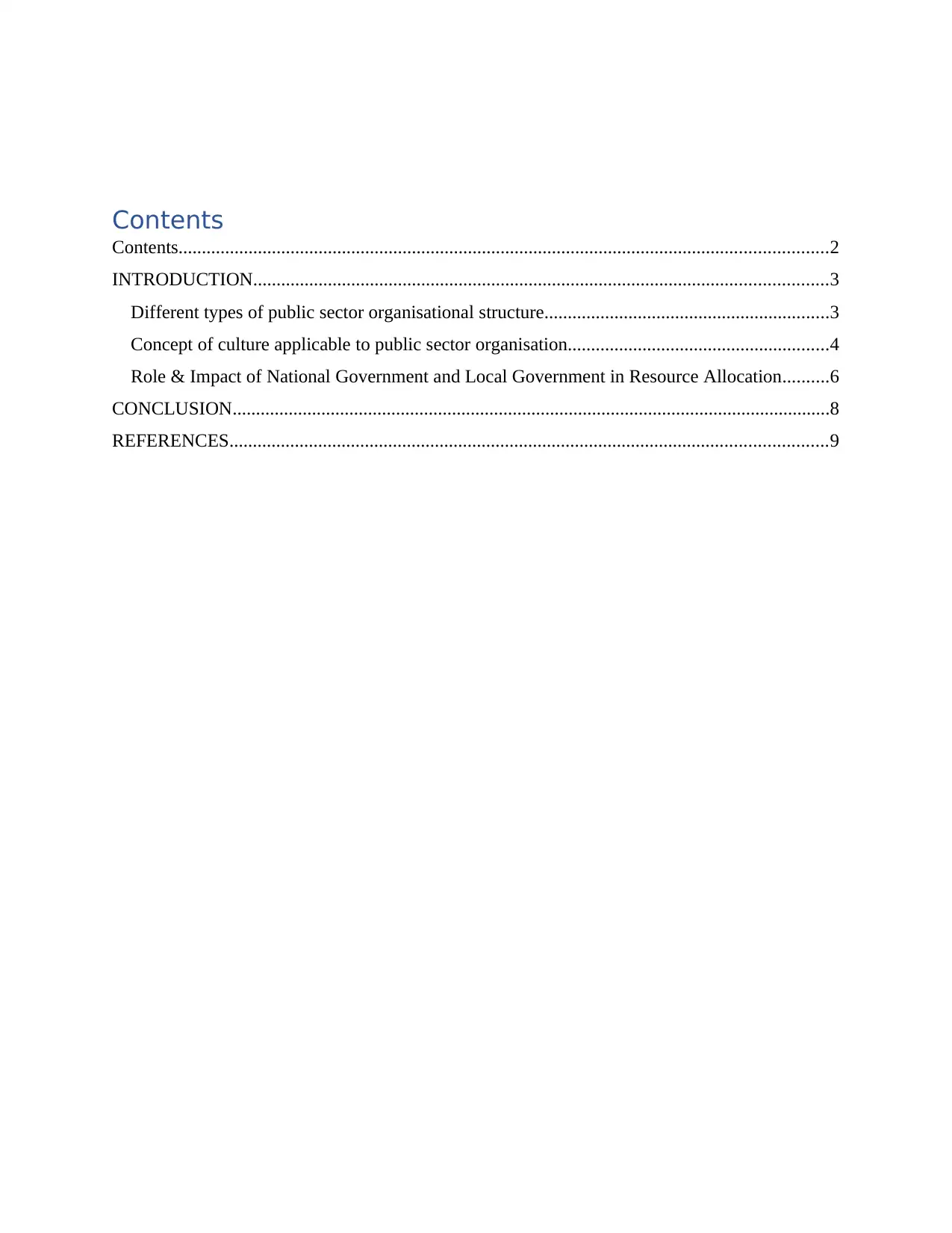
Contents
Contents...........................................................................................................................................2
INTRODUCTION...........................................................................................................................3
Different types of public sector organisational structure.............................................................3
Concept of culture applicable to public sector organisation........................................................4
Role & Impact of National Government and Local Government in Resource Allocation..........6
CONCLUSION................................................................................................................................8
REFERENCES................................................................................................................................9
Contents...........................................................................................................................................2
INTRODUCTION...........................................................................................................................3
Different types of public sector organisational structure.............................................................3
Concept of culture applicable to public sector organisation........................................................4
Role & Impact of National Government and Local Government in Resource Allocation..........6
CONCLUSION................................................................................................................................8
REFERENCES................................................................................................................................9
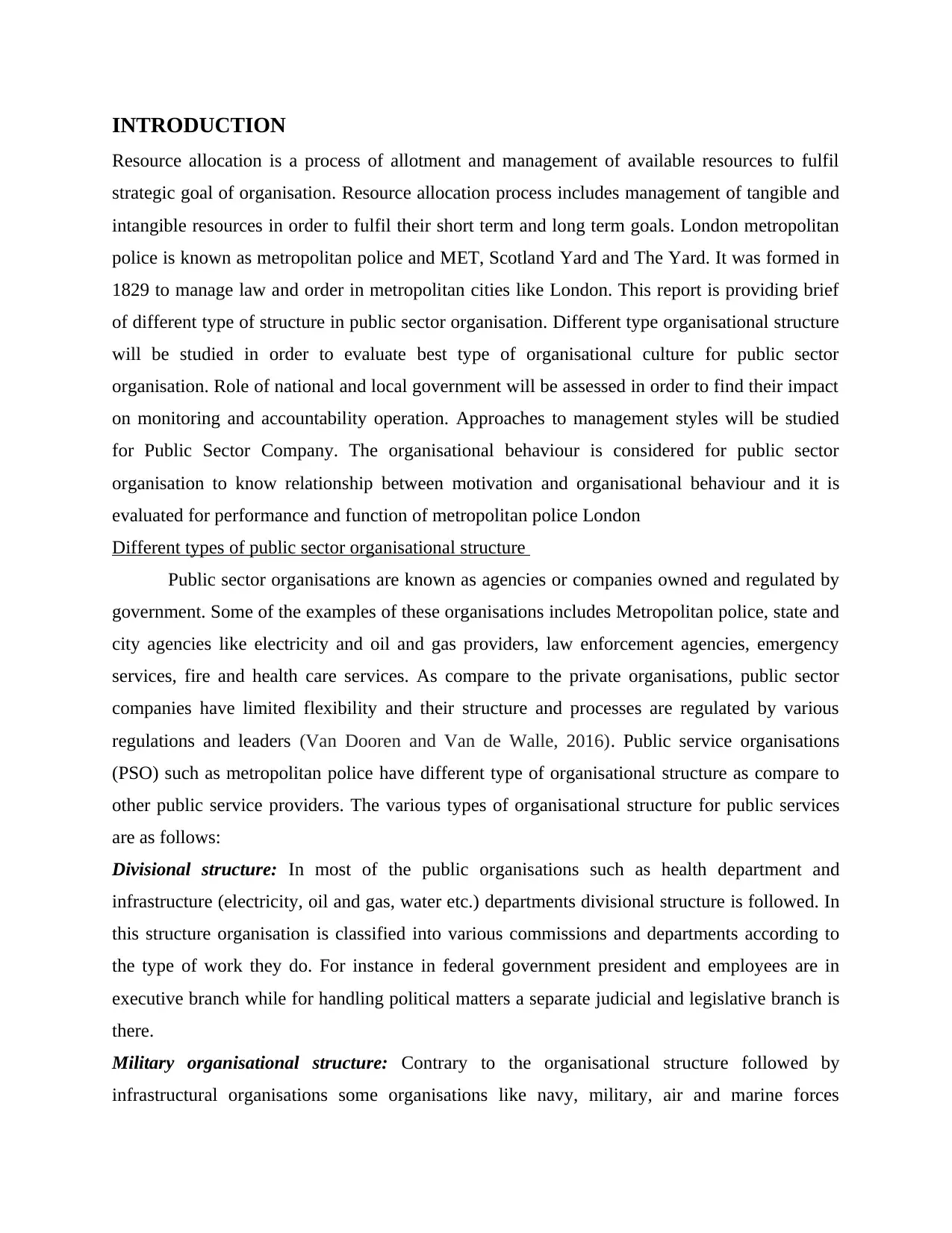
INTRODUCTION
Resource allocation is a process of allotment and management of available resources to fulfil
strategic goal of organisation. Resource allocation process includes management of tangible and
intangible resources in order to fulfil their short term and long term goals. London metropolitan
police is known as metropolitan police and MET, Scotland Yard and The Yard. It was formed in
1829 to manage law and order in metropolitan cities like London. This report is providing brief
of different type of structure in public sector organisation. Different type organisational structure
will be studied in order to evaluate best type of organisational culture for public sector
organisation. Role of national and local government will be assessed in order to find their impact
on monitoring and accountability operation. Approaches to management styles will be studied
for Public Sector Company. The organisational behaviour is considered for public sector
organisation to know relationship between motivation and organisational behaviour and it is
evaluated for performance and function of metropolitan police London
Different types of public sector organisational structure
Public sector organisations are known as agencies or companies owned and regulated by
government. Some of the examples of these organisations includes Metropolitan police, state and
city agencies like electricity and oil and gas providers, law enforcement agencies, emergency
services, fire and health care services. As compare to the private organisations, public sector
companies have limited flexibility and their structure and processes are regulated by various
regulations and leaders (Van Dooren and Van de Walle, 2016). Public service organisations
(PSO) such as metropolitan police have different type of organisational structure as compare to
other public service providers. The various types of organisational structure for public services
are as follows:
Divisional structure: In most of the public organisations such as health department and
infrastructure (electricity, oil and gas, water etc.) departments divisional structure is followed. In
this structure organisation is classified into various commissions and departments according to
the type of work they do. For instance in federal government president and employees are in
executive branch while for handling political matters a separate judicial and legislative branch is
there.
Military organisational structure: Contrary to the organisational structure followed by
infrastructural organisations some organisations like navy, military, air and marine forces
Resource allocation is a process of allotment and management of available resources to fulfil
strategic goal of organisation. Resource allocation process includes management of tangible and
intangible resources in order to fulfil their short term and long term goals. London metropolitan
police is known as metropolitan police and MET, Scotland Yard and The Yard. It was formed in
1829 to manage law and order in metropolitan cities like London. This report is providing brief
of different type of structure in public sector organisation. Different type organisational structure
will be studied in order to evaluate best type of organisational culture for public sector
organisation. Role of national and local government will be assessed in order to find their impact
on monitoring and accountability operation. Approaches to management styles will be studied
for Public Sector Company. The organisational behaviour is considered for public sector
organisation to know relationship between motivation and organisational behaviour and it is
evaluated for performance and function of metropolitan police London
Different types of public sector organisational structure
Public sector organisations are known as agencies or companies owned and regulated by
government. Some of the examples of these organisations includes Metropolitan police, state and
city agencies like electricity and oil and gas providers, law enforcement agencies, emergency
services, fire and health care services. As compare to the private organisations, public sector
companies have limited flexibility and their structure and processes are regulated by various
regulations and leaders (Van Dooren and Van de Walle, 2016). Public service organisations
(PSO) such as metropolitan police have different type of organisational structure as compare to
other public service providers. The various types of organisational structure for public services
are as follows:
Divisional structure: In most of the public organisations such as health department and
infrastructure (electricity, oil and gas, water etc.) departments divisional structure is followed. In
this structure organisation is classified into various commissions and departments according to
the type of work they do. For instance in federal government president and employees are in
executive branch while for handling political matters a separate judicial and legislative branch is
there.
Military organisational structure: Contrary to the organisational structure followed by
infrastructural organisations some organisations like navy, military, air and marine forces
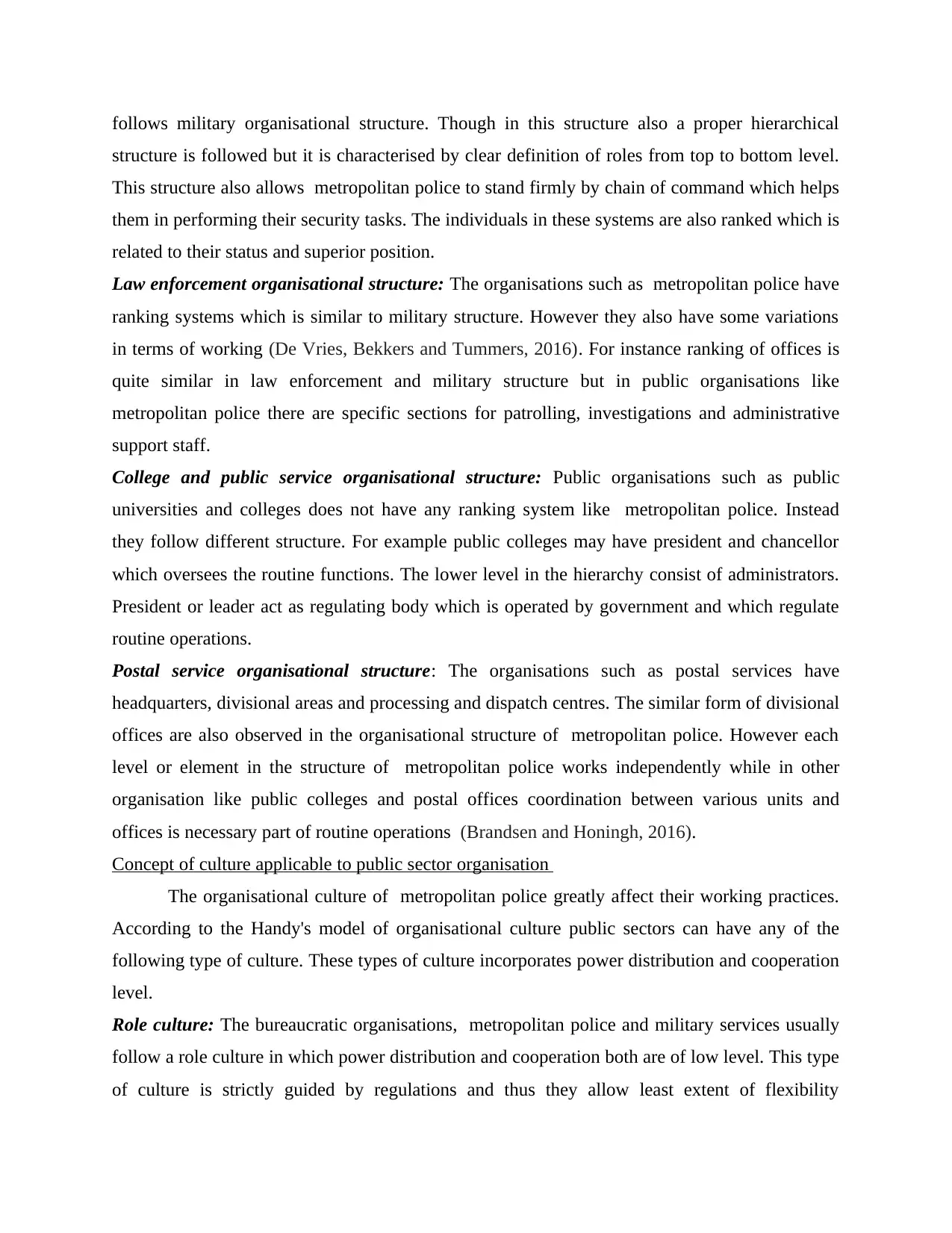
follows military organisational structure. Though in this structure also a proper hierarchical
structure is followed but it is characterised by clear definition of roles from top to bottom level.
This structure also allows metropolitan police to stand firmly by chain of command which helps
them in performing their security tasks. The individuals in these systems are also ranked which is
related to their status and superior position.
Law enforcement organisational structure: The organisations such as metropolitan police have
ranking systems which is similar to military structure. However they also have some variations
in terms of working (De Vries, Bekkers and Tummers, 2016). For instance ranking of offices is
quite similar in law enforcement and military structure but in public organisations like
metropolitan police there are specific sections for patrolling, investigations and administrative
support staff.
College and public service organisational structure: Public organisations such as public
universities and colleges does not have any ranking system like metropolitan police. Instead
they follow different structure. For example public colleges may have president and chancellor
which oversees the routine functions. The lower level in the hierarchy consist of administrators.
President or leader act as regulating body which is operated by government and which regulate
routine operations.
Postal service organisational structure: The organisations such as postal services have
headquarters, divisional areas and processing and dispatch centres. The similar form of divisional
offices are also observed in the organisational structure of metropolitan police. However each
level or element in the structure of metropolitan police works independently while in other
organisation like public colleges and postal offices coordination between various units and
offices is necessary part of routine operations (Brandsen and Honingh, 2016).
Concept of culture applicable to public sector organisation
The organisational culture of metropolitan police greatly affect their working practices.
According to the Handy's model of organisational culture public sectors can have any of the
following type of culture. These types of culture incorporates power distribution and cooperation
level.
Role culture: The bureaucratic organisations, metropolitan police and military services usually
follow a role culture in which power distribution and cooperation both are of low level. This type
of culture is strictly guided by regulations and thus they allow least extent of flexibility
structure is followed but it is characterised by clear definition of roles from top to bottom level.
This structure also allows metropolitan police to stand firmly by chain of command which helps
them in performing their security tasks. The individuals in these systems are also ranked which is
related to their status and superior position.
Law enforcement organisational structure: The organisations such as metropolitan police have
ranking systems which is similar to military structure. However they also have some variations
in terms of working (De Vries, Bekkers and Tummers, 2016). For instance ranking of offices is
quite similar in law enforcement and military structure but in public organisations like
metropolitan police there are specific sections for patrolling, investigations and administrative
support staff.
College and public service organisational structure: Public organisations such as public
universities and colleges does not have any ranking system like metropolitan police. Instead
they follow different structure. For example public colleges may have president and chancellor
which oversees the routine functions. The lower level in the hierarchy consist of administrators.
President or leader act as regulating body which is operated by government and which regulate
routine operations.
Postal service organisational structure: The organisations such as postal services have
headquarters, divisional areas and processing and dispatch centres. The similar form of divisional
offices are also observed in the organisational structure of metropolitan police. However each
level or element in the structure of metropolitan police works independently while in other
organisation like public colleges and postal offices coordination between various units and
offices is necessary part of routine operations (Brandsen and Honingh, 2016).
Concept of culture applicable to public sector organisation
The organisational culture of metropolitan police greatly affect their working practices.
According to the Handy's model of organisational culture public sectors can have any of the
following type of culture. These types of culture incorporates power distribution and cooperation
level.
Role culture: The bureaucratic organisations, metropolitan police and military services usually
follow a role culture in which power distribution and cooperation both are of low level. This type
of culture is strictly guided by regulations and thus they allow least extent of flexibility
Secure Best Marks with AI Grader
Need help grading? Try our AI Grader for instant feedback on your assignments.
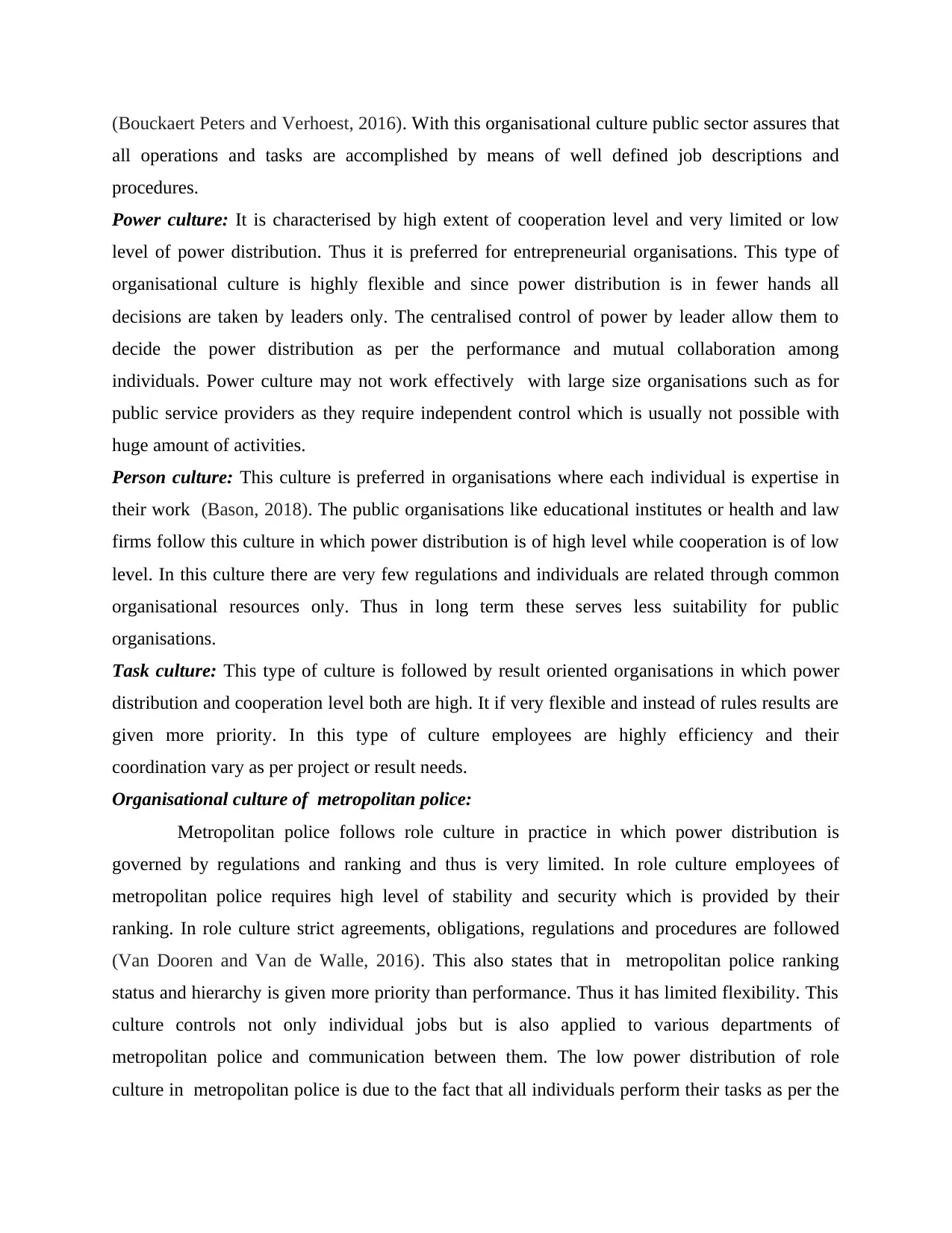
(Bouckaert Peters and Verhoest, 2016). With this organisational culture public sector assures that
all operations and tasks are accomplished by means of well defined job descriptions and
procedures.
Power culture: It is characterised by high extent of cooperation level and very limited or low
level of power distribution. Thus it is preferred for entrepreneurial organisations. This type of
organisational culture is highly flexible and since power distribution is in fewer hands all
decisions are taken by leaders only. The centralised control of power by leader allow them to
decide the power distribution as per the performance and mutual collaboration among
individuals. Power culture may not work effectively with large size organisations such as for
public service providers as they require independent control which is usually not possible with
huge amount of activities.
Person culture: This culture is preferred in organisations where each individual is expertise in
their work (Bason, 2018). The public organisations like educational institutes or health and law
firms follow this culture in which power distribution is of high level while cooperation is of low
level. In this culture there are very few regulations and individuals are related through common
organisational resources only. Thus in long term these serves less suitability for public
organisations.
Task culture: This type of culture is followed by result oriented organisations in which power
distribution and cooperation level both are high. It if very flexible and instead of rules results are
given more priority. In this type of culture employees are highly efficiency and their
coordination vary as per project or result needs.
Organisational culture of metropolitan police:
Metropolitan police follows role culture in practice in which power distribution is
governed by regulations and ranking and thus is very limited. In role culture employees of
metropolitan police requires high level of stability and security which is provided by their
ranking. In role culture strict agreements, obligations, regulations and procedures are followed
(Van Dooren and Van de Walle, 2016). This also states that in metropolitan police ranking
status and hierarchy is given more priority than performance. Thus it has limited flexibility. This
culture controls not only individual jobs but is also applied to various departments of
metropolitan police and communication between them. The low power distribution of role
culture in metropolitan police is due to the fact that all individuals perform their tasks as per the
all operations and tasks are accomplished by means of well defined job descriptions and
procedures.
Power culture: It is characterised by high extent of cooperation level and very limited or low
level of power distribution. Thus it is preferred for entrepreneurial organisations. This type of
organisational culture is highly flexible and since power distribution is in fewer hands all
decisions are taken by leaders only. The centralised control of power by leader allow them to
decide the power distribution as per the performance and mutual collaboration among
individuals. Power culture may not work effectively with large size organisations such as for
public service providers as they require independent control which is usually not possible with
huge amount of activities.
Person culture: This culture is preferred in organisations where each individual is expertise in
their work (Bason, 2018). The public organisations like educational institutes or health and law
firms follow this culture in which power distribution is of high level while cooperation is of low
level. In this culture there are very few regulations and individuals are related through common
organisational resources only. Thus in long term these serves less suitability for public
organisations.
Task culture: This type of culture is followed by result oriented organisations in which power
distribution and cooperation level both are high. It if very flexible and instead of rules results are
given more priority. In this type of culture employees are highly efficiency and their
coordination vary as per project or result needs.
Organisational culture of metropolitan police:
Metropolitan police follows role culture in practice in which power distribution is
governed by regulations and ranking and thus is very limited. In role culture employees of
metropolitan police requires high level of stability and security which is provided by their
ranking. In role culture strict agreements, obligations, regulations and procedures are followed
(Van Dooren and Van de Walle, 2016). This also states that in metropolitan police ranking
status and hierarchy is given more priority than performance. Thus it has limited flexibility. This
culture controls not only individual jobs but is also applied to various departments of
metropolitan police and communication between them. The low power distribution of role
culture in metropolitan police is due to the fact that all individuals perform their tasks as per the
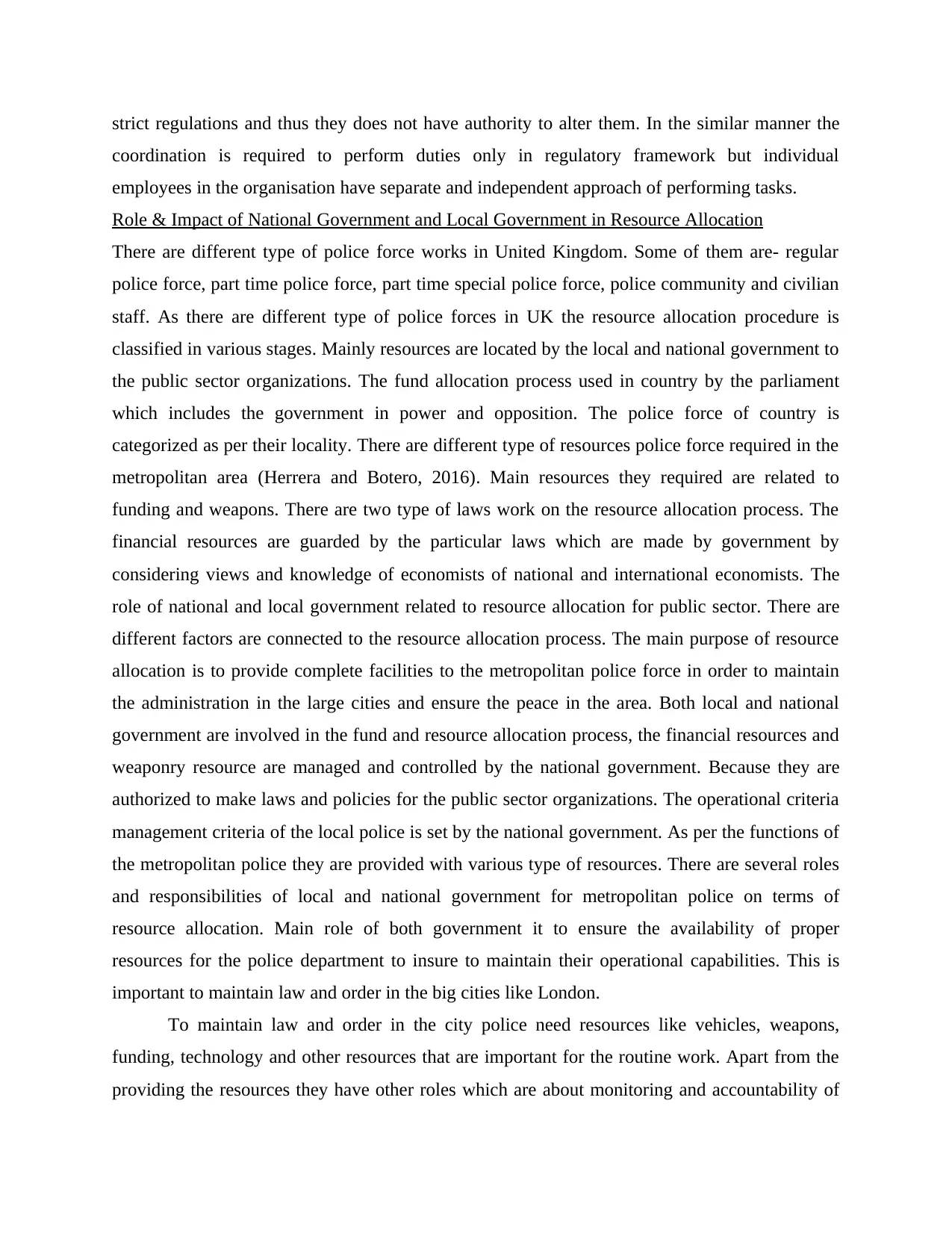
strict regulations and thus they does not have authority to alter them. In the similar manner the
coordination is required to perform duties only in regulatory framework but individual
employees in the organisation have separate and independent approach of performing tasks.
Role & Impact of National Government and Local Government in Resource Allocation
There are different type of police force works in United Kingdom. Some of them are- regular
police force, part time police force, part time special police force, police community and civilian
staff. As there are different type of police forces in UK the resource allocation procedure is
classified in various stages. Mainly resources are located by the local and national government to
the public sector organizations. The fund allocation process used in country by the parliament
which includes the government in power and opposition. The police force of country is
categorized as per their locality. There are different type of resources police force required in the
metropolitan area (Herrera and Botero, 2016). Main resources they required are related to
funding and weapons. There are two type of laws work on the resource allocation process. The
financial resources are guarded by the particular laws which are made by government by
considering views and knowledge of economists of national and international economists. The
role of national and local government related to resource allocation for public sector. There are
different factors are connected to the resource allocation process. The main purpose of resource
allocation is to provide complete facilities to the metropolitan police force in order to maintain
the administration in the large cities and ensure the peace in the area. Both local and national
government are involved in the fund and resource allocation process, the financial resources and
weaponry resource are managed and controlled by the national government. Because they are
authorized to make laws and policies for the public sector organizations. The operational criteria
management criteria of the local police is set by the national government. As per the functions of
the metropolitan police they are provided with various type of resources. There are several roles
and responsibilities of local and national government for metropolitan police on terms of
resource allocation. Main role of both government it to ensure the availability of proper
resources for the police department to insure to maintain their operational capabilities. This is
important to maintain law and order in the big cities like London.
To maintain law and order in the city police need resources like vehicles, weapons,
funding, technology and other resources that are important for the routine work. Apart from the
providing the resources they have other roles which are about monitoring and accountability of
coordination is required to perform duties only in regulatory framework but individual
employees in the organisation have separate and independent approach of performing tasks.
Role & Impact of National Government and Local Government in Resource Allocation
There are different type of police force works in United Kingdom. Some of them are- regular
police force, part time police force, part time special police force, police community and civilian
staff. As there are different type of police forces in UK the resource allocation procedure is
classified in various stages. Mainly resources are located by the local and national government to
the public sector organizations. The fund allocation process used in country by the parliament
which includes the government in power and opposition. The police force of country is
categorized as per their locality. There are different type of resources police force required in the
metropolitan area (Herrera and Botero, 2016). Main resources they required are related to
funding and weapons. There are two type of laws work on the resource allocation process. The
financial resources are guarded by the particular laws which are made by government by
considering views and knowledge of economists of national and international economists. The
role of national and local government related to resource allocation for public sector. There are
different factors are connected to the resource allocation process. The main purpose of resource
allocation is to provide complete facilities to the metropolitan police force in order to maintain
the administration in the large cities and ensure the peace in the area. Both local and national
government are involved in the fund and resource allocation process, the financial resources and
weaponry resource are managed and controlled by the national government. Because they are
authorized to make laws and policies for the public sector organizations. The operational criteria
management criteria of the local police is set by the national government. As per the functions of
the metropolitan police they are provided with various type of resources. There are several roles
and responsibilities of local and national government for metropolitan police on terms of
resource allocation. Main role of both government it to ensure the availability of proper
resources for the police department to insure to maintain their operational capabilities. This is
important to maintain law and order in the big cities like London.
To maintain law and order in the city police need resources like vehicles, weapons,
funding, technology and other resources that are important for the routine work. Apart from the
providing the resources they have other roles which are about monitoring and accountability of
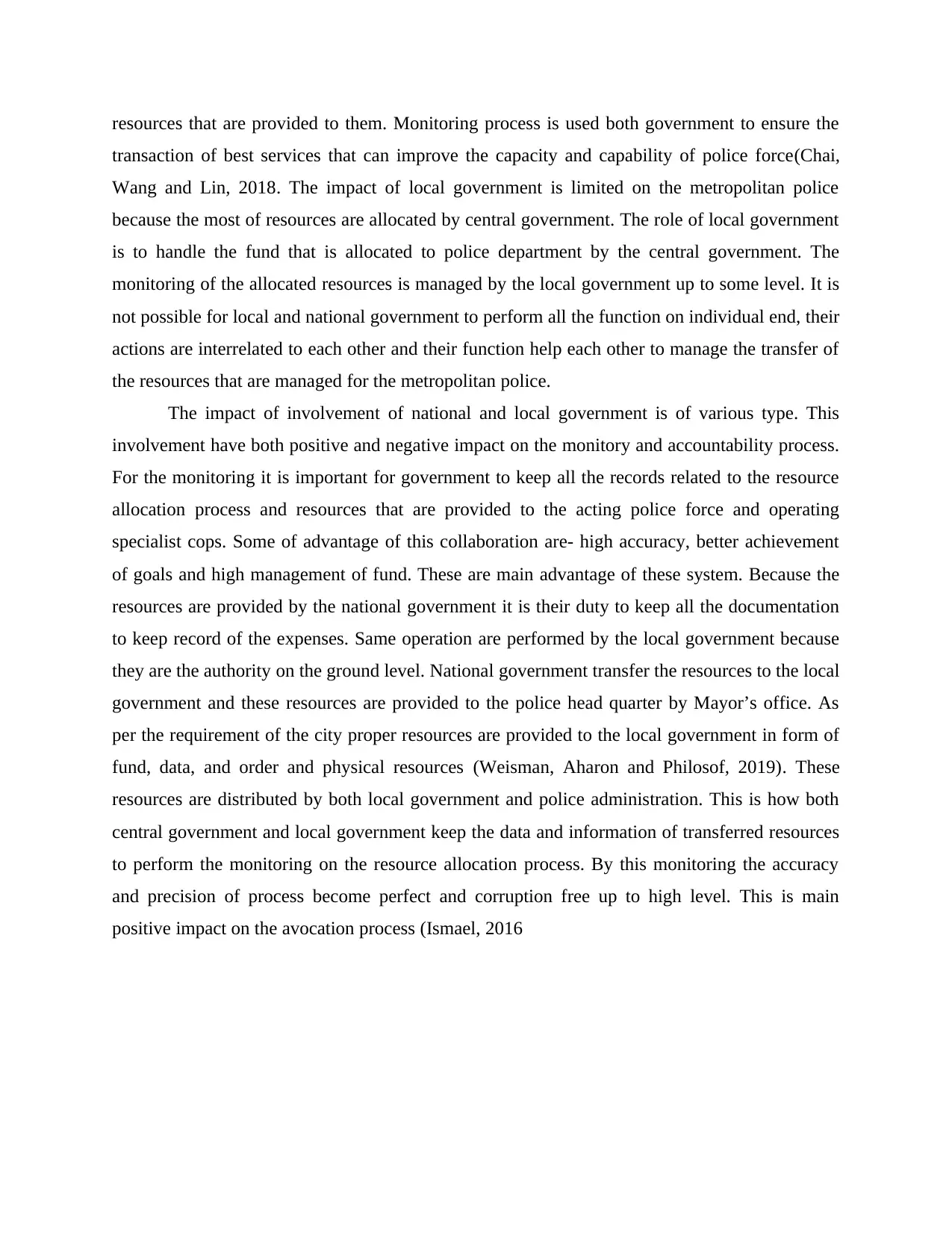
resources that are provided to them. Monitoring process is used both government to ensure the
transaction of best services that can improve the capacity and capability of police force(Chai,
Wang and Lin, 2018. The impact of local government is limited on the metropolitan police
because the most of resources are allocated by central government. The role of local government
is to handle the fund that is allocated to police department by the central government. The
monitoring of the allocated resources is managed by the local government up to some level. It is
not possible for local and national government to perform all the function on individual end, their
actions are interrelated to each other and their function help each other to manage the transfer of
the resources that are managed for the metropolitan police.
The impact of involvement of national and local government is of various type. This
involvement have both positive and negative impact on the monitory and accountability process.
For the monitoring it is important for government to keep all the records related to the resource
allocation process and resources that are provided to the acting police force and operating
specialist cops. Some of advantage of this collaboration are- high accuracy, better achievement
of goals and high management of fund. These are main advantage of these system. Because the
resources are provided by the national government it is their duty to keep all the documentation
to keep record of the expenses. Same operation are performed by the local government because
they are the authority on the ground level. National government transfer the resources to the local
government and these resources are provided to the police head quarter by Mayor’s office. As
per the requirement of the city proper resources are provided to the local government in form of
fund, data, and order and physical resources (Weisman, Aharon and Philosof, 2019). These
resources are distributed by both local government and police administration. This is how both
central government and local government keep the data and information of transferred resources
to perform the monitoring on the resource allocation process. By this monitoring the accuracy
and precision of process become perfect and corruption free up to high level. This is main
positive impact on the avocation process (Ismael, 2016
transaction of best services that can improve the capacity and capability of police force(Chai,
Wang and Lin, 2018. The impact of local government is limited on the metropolitan police
because the most of resources are allocated by central government. The role of local government
is to handle the fund that is allocated to police department by the central government. The
monitoring of the allocated resources is managed by the local government up to some level. It is
not possible for local and national government to perform all the function on individual end, their
actions are interrelated to each other and their function help each other to manage the transfer of
the resources that are managed for the metropolitan police.
The impact of involvement of national and local government is of various type. This
involvement have both positive and negative impact on the monitory and accountability process.
For the monitoring it is important for government to keep all the records related to the resource
allocation process and resources that are provided to the acting police force and operating
specialist cops. Some of advantage of this collaboration are- high accuracy, better achievement
of goals and high management of fund. These are main advantage of these system. Because the
resources are provided by the national government it is their duty to keep all the documentation
to keep record of the expenses. Same operation are performed by the local government because
they are the authority on the ground level. National government transfer the resources to the local
government and these resources are provided to the police head quarter by Mayor’s office. As
per the requirement of the city proper resources are provided to the local government in form of
fund, data, and order and physical resources (Weisman, Aharon and Philosof, 2019). These
resources are distributed by both local government and police administration. This is how both
central government and local government keep the data and information of transferred resources
to perform the monitoring on the resource allocation process. By this monitoring the accuracy
and precision of process become perfect and corruption free up to high level. This is main
positive impact on the avocation process (Ismael, 2016
Paraphrase This Document
Need a fresh take? Get an instant paraphrase of this document with our AI Paraphraser
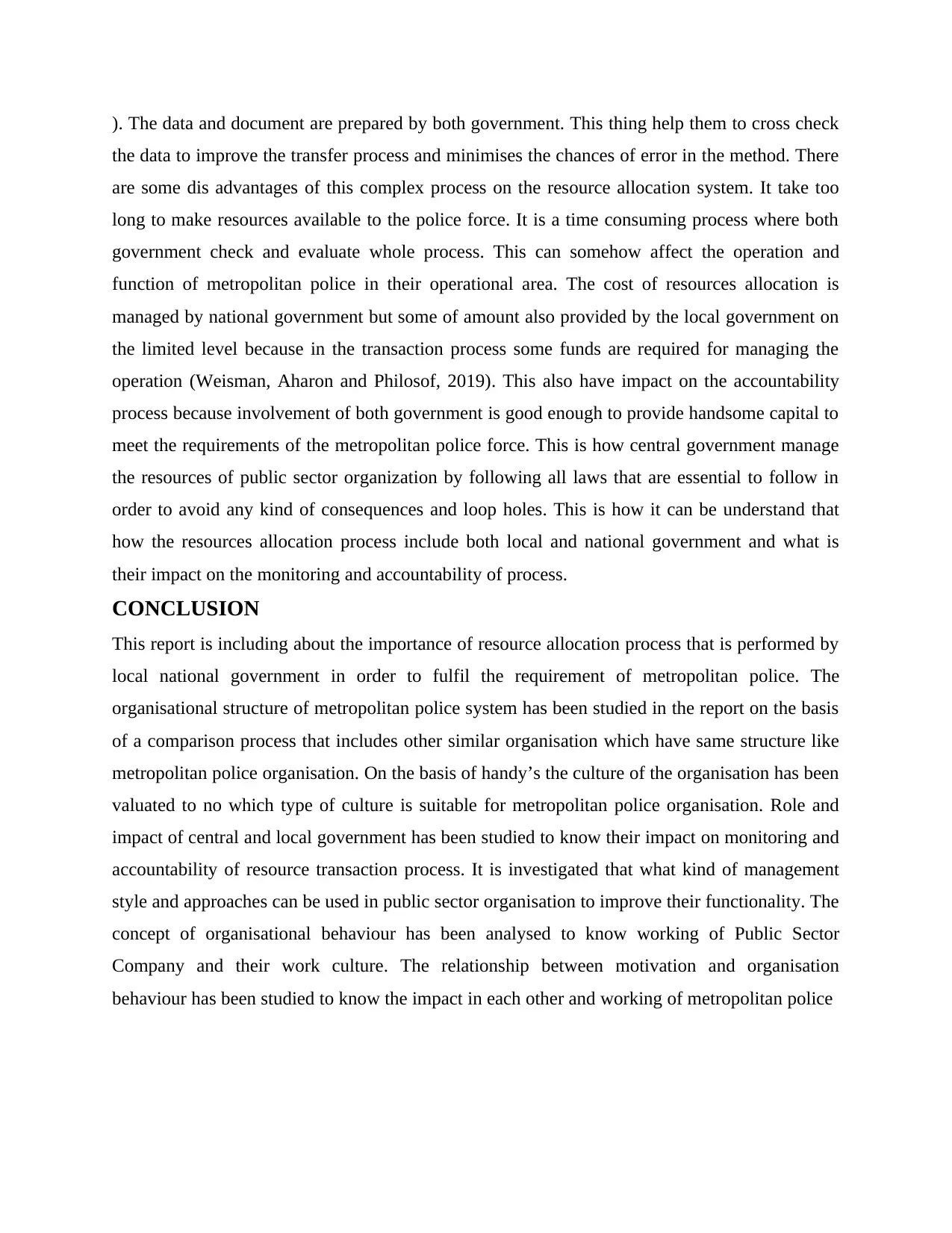
). The data and document are prepared by both government. This thing help them to cross check
the data to improve the transfer process and minimises the chances of error in the method. There
are some dis advantages of this complex process on the resource allocation system. It take too
long to make resources available to the police force. It is a time consuming process where both
government check and evaluate whole process. This can somehow affect the operation and
function of metropolitan police in their operational area. The cost of resources allocation is
managed by national government but some of amount also provided by the local government on
the limited level because in the transaction process some funds are required for managing the
operation (Weisman, Aharon and Philosof, 2019). This also have impact on the accountability
process because involvement of both government is good enough to provide handsome capital to
meet the requirements of the metropolitan police force. This is how central government manage
the resources of public sector organization by following all laws that are essential to follow in
order to avoid any kind of consequences and loop holes. This is how it can be understand that
how the resources allocation process include both local and national government and what is
their impact on the monitoring and accountability of process.
CONCLUSION
This report is including about the importance of resource allocation process that is performed by
local national government in order to fulfil the requirement of metropolitan police. The
organisational structure of metropolitan police system has been studied in the report on the basis
of a comparison process that includes other similar organisation which have same structure like
metropolitan police organisation. On the basis of handy’s the culture of the organisation has been
valuated to no which type of culture is suitable for metropolitan police organisation. Role and
impact of central and local government has been studied to know their impact on monitoring and
accountability of resource transaction process. It is investigated that what kind of management
style and approaches can be used in public sector organisation to improve their functionality. The
concept of organisational behaviour has been analysed to know working of Public Sector
Company and their work culture. The relationship between motivation and organisation
behaviour has been studied to know the impact in each other and working of metropolitan police
the data to improve the transfer process and minimises the chances of error in the method. There
are some dis advantages of this complex process on the resource allocation system. It take too
long to make resources available to the police force. It is a time consuming process where both
government check and evaluate whole process. This can somehow affect the operation and
function of metropolitan police in their operational area. The cost of resources allocation is
managed by national government but some of amount also provided by the local government on
the limited level because in the transaction process some funds are required for managing the
operation (Weisman, Aharon and Philosof, 2019). This also have impact on the accountability
process because involvement of both government is good enough to provide handsome capital to
meet the requirements of the metropolitan police force. This is how central government manage
the resources of public sector organization by following all laws that are essential to follow in
order to avoid any kind of consequences and loop holes. This is how it can be understand that
how the resources allocation process include both local and national government and what is
their impact on the monitoring and accountability of process.
CONCLUSION
This report is including about the importance of resource allocation process that is performed by
local national government in order to fulfil the requirement of metropolitan police. The
organisational structure of metropolitan police system has been studied in the report on the basis
of a comparison process that includes other similar organisation which have same structure like
metropolitan police organisation. On the basis of handy’s the culture of the organisation has been
valuated to no which type of culture is suitable for metropolitan police organisation. Role and
impact of central and local government has been studied to know their impact on monitoring and
accountability of resource transaction process. It is investigated that what kind of management
style and approaches can be used in public sector organisation to improve their functionality. The
concept of organisational behaviour has been analysed to know working of Public Sector
Company and their work culture. The relationship between motivation and organisation
behaviour has been studied to know the impact in each other and working of metropolitan police
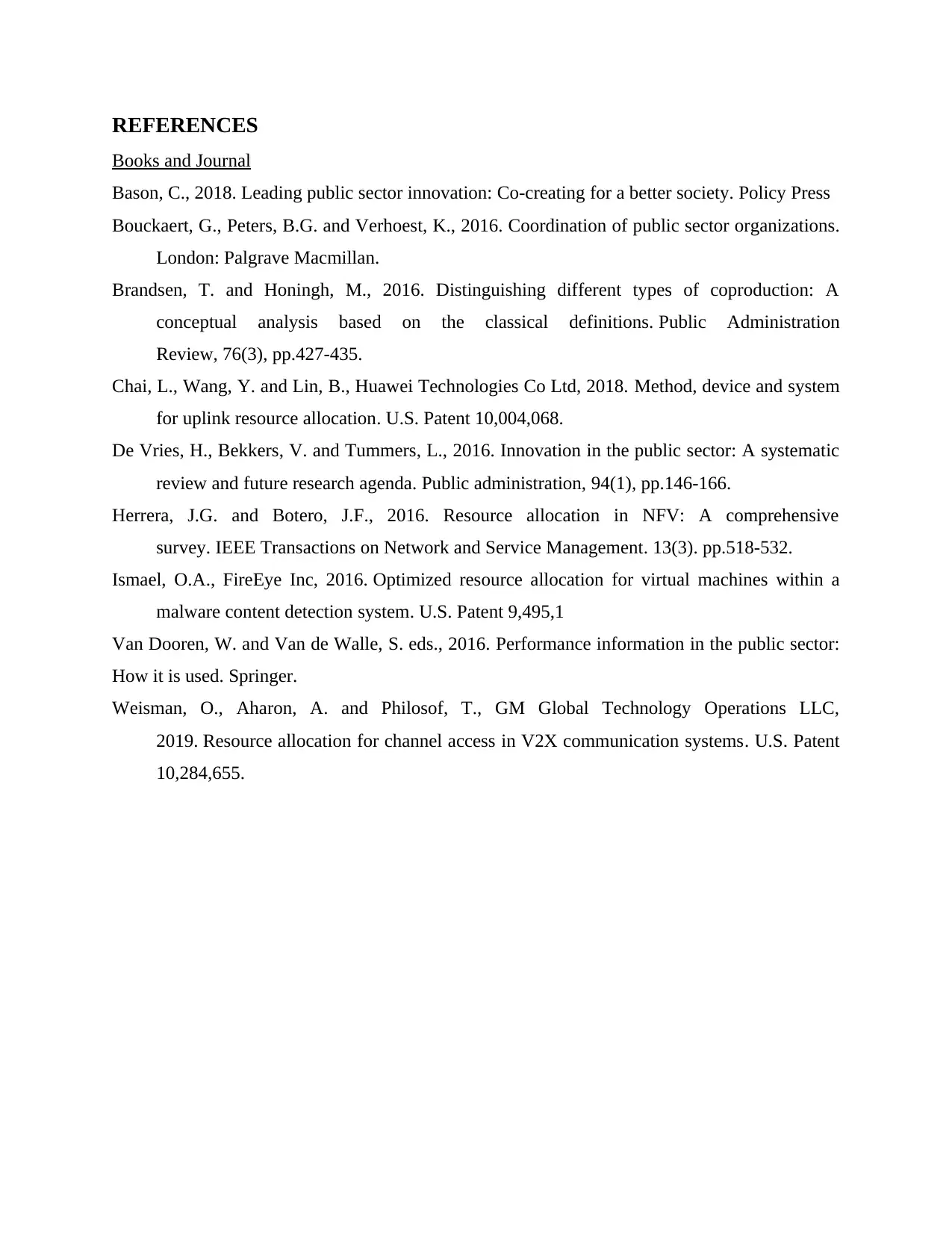
REFERENCES
Books and Journal
Bason, C., 2018. Leading public sector innovation: Co-creating for a better society. Policy Press
Bouckaert, G., Peters, B.G. and Verhoest, K., 2016. Coordination of public sector organizations.
London: Palgrave Macmillan.
Brandsen, T. and Honingh, M., 2016. Distinguishing different types of coproduction: A
conceptual analysis based on the classical definitions. Public Administration
Review, 76(3), pp.427-435.
Chai, L., Wang, Y. and Lin, B., Huawei Technologies Co Ltd, 2018. Method, device and system
for uplink resource allocation. U.S. Patent 10,004,068.
De Vries, H., Bekkers, V. and Tummers, L., 2016. Innovation in the public sector: A systematic
review and future research agenda. Public administration, 94(1), pp.146-166.
Herrera, J.G. and Botero, J.F., 2016. Resource allocation in NFV: A comprehensive
survey. IEEE Transactions on Network and Service Management. 13(3). pp.518-532.
Ismael, O.A., FireEye Inc, 2016. Optimized resource allocation for virtual machines within a
malware content detection system. U.S. Patent 9,495,1
Van Dooren, W. and Van de Walle, S. eds., 2016. Performance information in the public sector:
How it is used. Springer.
Weisman, O., Aharon, A. and Philosof, T., GM Global Technology Operations LLC,
2019. Resource allocation for channel access in V2X communication systems. U.S. Patent
10,284,655.
Books and Journal
Bason, C., 2018. Leading public sector innovation: Co-creating for a better society. Policy Press
Bouckaert, G., Peters, B.G. and Verhoest, K., 2016. Coordination of public sector organizations.
London: Palgrave Macmillan.
Brandsen, T. and Honingh, M., 2016. Distinguishing different types of coproduction: A
conceptual analysis based on the classical definitions. Public Administration
Review, 76(3), pp.427-435.
Chai, L., Wang, Y. and Lin, B., Huawei Technologies Co Ltd, 2018. Method, device and system
for uplink resource allocation. U.S. Patent 10,004,068.
De Vries, H., Bekkers, V. and Tummers, L., 2016. Innovation in the public sector: A systematic
review and future research agenda. Public administration, 94(1), pp.146-166.
Herrera, J.G. and Botero, J.F., 2016. Resource allocation in NFV: A comprehensive
survey. IEEE Transactions on Network and Service Management. 13(3). pp.518-532.
Ismael, O.A., FireEye Inc, 2016. Optimized resource allocation for virtual machines within a
malware content detection system. U.S. Patent 9,495,1
Van Dooren, W. and Van de Walle, S. eds., 2016. Performance information in the public sector:
How it is used. Springer.
Weisman, O., Aharon, A. and Philosof, T., GM Global Technology Operations LLC,
2019. Resource allocation for channel access in V2X communication systems. U.S. Patent
10,284,655.

Secure Best Marks with AI Grader
Need help grading? Try our AI Grader for instant feedback on your assignments.

1
1 out of 11
Related Documents
Your All-in-One AI-Powered Toolkit for Academic Success.
+13062052269
info@desklib.com
Available 24*7 on WhatsApp / Email
![[object Object]](/_next/static/media/star-bottom.7253800d.svg)
Unlock your academic potential
© 2024 | Zucol Services PVT LTD | All rights reserved.





